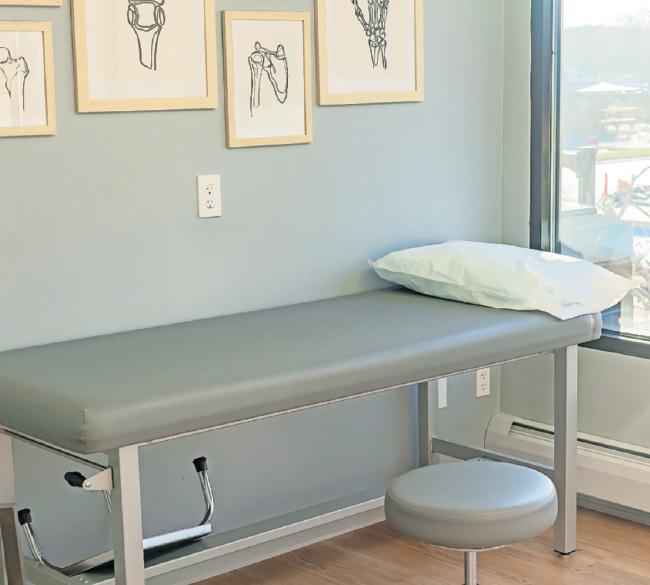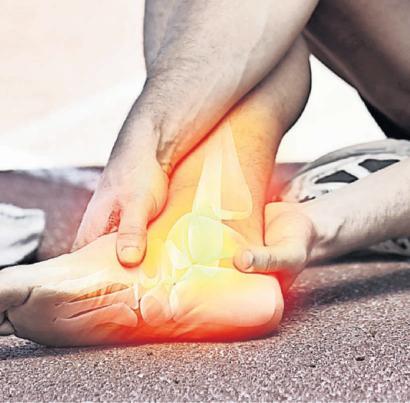Better Health
MOVIES: Holiday gift ideas,
MUSIC: Best new holiday releases, D7
TECH: Gadget gift ideas, D7



Moblity is so important we have learned over the years that getting patients who are recovering from surgery or injury up and moving is essential
- Dr. Paul B. Murray




 By C ori U rban
Special To The Republican
By C ori U rban
Special To The Republican
Dr. Paul B. Murray, a board-certified, fellowship-trained orthopedic surgeon specializing in the treatment of conditions involving the hip and knee, has been using robotics in his practice for nearly a decade; he said he was the first surgeon in Connecticut to perform a robotic-assisted total knee replacement.
“I use Mako SmartRobotics® technology, which is an innovative 3D CT-based software to plan and create a personalized joint replacement surgical plan,” explained the doctor at The Orthopedic Center of Connecticut, a practice he shares with Dr. Michael Aron.

Commenting on the benefits of using the Mako technology, Murray said, “The preoperative CT-scan planning allows for greater precision. There is better balancing of the soft tissue areas in the joint, and this allows for better alignment of the joint.”
He performs the surgery, but the Mako’s robotic arm assists during surgery to position the implant.
According to Murray, robotics has revolutionized his surgeries: “We obtain a preoperative CT scan to assess the anatomy of the joint. Then the Mako SmartRobotics® technology uses 3D CT-based software to
determine the most precise location for the implant. We used to plan for surgery using plain radiographs and rulers. This is incredibly precise (tool) and has revolutionized the entire process.”
Patients are “thrilled” to learn that he is utilizing the latest technologies to ensure the best outcomes, he said. “Many ask if I am still performing the surgery and are happy to hear that I only use the robotic technology to assist with the operative plan.”
Every patient can benefit from this technology. But, like any surgery, joint replacement surgery has risks that include — but are not limited to — pain, infection, fracture or implant failure.
He performs more than 500 surgeries every year and sees approximately 100 patients per week in his three offices — Farmington, Enfield and Glastonbury. Though he does have a physician assistant that works with him, he personally sees every patient. “I believe that sets me apart. I know that my patients come to me for my expertise, and they each deserve my time and attention,” he said. “We truly believe that every patient is different. From the time a patient is seen in our office until and through their recovery, we are there every step of the way. We customize a plan that works to achieve their desired outcome,” he added.
Patients are “thrilled” to learn that he is using the latest technologies to ensure the best outcomes.
“Mobility is so important. We have learned over the years that getting patients who are recovering from surgery or an injury up and moving is essential,” said Murray, who has 30 years of orthopedic surgery experience in the greater Hartford area. Activities within tolerance and guided by a skilled physical therapist will ensure the best outcome.
“We used to delay joint replacement surgery until patients had lost much of their mobility, but we now work with each patient to time surgery and formulate a treatment plan that works to keep them living their active lifestyle,” Murray added.
Follow-up care depends on the patient. Post-surgical patients receive multiple office visits and physical therapy sessions.
The trend is to have shorter hospital stays and move patients toward a recovery in the comfort of their own home. “Outcomes are improved when patients are mobile and getting back to their daily routines as soon as possible,” Dr. Murray said.
For more information, go to murrayjointmd.com.


FAT to hold annual holiday show Dec. 29 at Divine Theater in Holyoke, masslive.com/entertainment
D7
Above: Interior photos of the Orthopedic Center of Connecticut. (PHOTOS COURTESY OF NATE BLAIS / THE REPUBLICAN) Dr. Paul B. Murray (PHOTO COURTESY OF NATE BLAIS / THE REPUBLICAN)
(PHOTO COURTESY OF ISTOCK) D | | SUNDAY, DECEMBER 10, 2023
Soft tissue





Soft tissue injuries are more common than people may realize.
In fact, anyone with an undiagnosed pain in his or her body may be suffering from a soft tissue injury.
According to Delaware Integrative Healthcare, bone injuries garner significant attention because broken bones and fractures can be very serious. But soft tissue injuries, when left untreated, also can be troublesome and jeopardize individuals’ athletic pursuits.
Verywell Health defines soft tissue injuries as trauma to any muscle, skin, tendon, or ligament in the body. Injuries may result from overuse or acute trauma, which is an external force applied to the body. Common examples of soft tissue injuries are lacerations, abrasions, contusions, sprains/strains, bursitis, and tendinitis.
Strains are injuries to muscles or tendons and sprains
are injuries to ligaments, which are elastic bands of tissue that connect and stabilize bones. Both strains and sprains are common soft tissue injuries. Bursitis and tendinitis also are common. Bursitis is an inflammation of the bursa, a fluid-filled sac that provides a cushion between the bones and muscles or tendons. Tendinitis is an inflammation of the tendons, which connect muscles to bones.
Many minor (Grade 1) soft tissue injuries that involve muscles, tendons and ligaments may heal when injured persons follow the protocol known as R.I.C.E., which is an acronym for Rest, Ice, Compression, and Elevation. R.I.C.E. is widely recommended for these types of injuries. However, more serious soft tissue injuries may take extended time to heal. Some of these injuries also may lead to permanent changes in muscles, tendons and ligaments, causing certain body parts to cease functioning how they used to. That may be the case with Grade 2 (moderate) or Grade 3 (severe) injuries. Further medical attention may be



needed and physical therapy may be prescribed.
The Ace Physical Therapy & Sports Medicine Institute says soft tissue injuries account for most of the injuries that outpatient physical therapists treat. A therapist will analyze the type of injury and the pain or impairment it is causing to develop a rehabilitation program. Physical therapists often perform various treatments geared toward reducing swelling and inflammation. Manual therapies to help restore normal motion also are part of soft tissue treatment plans. Stretching and strengthening exercises may be incorporated to improve endurance and repair soft tissue. Orthotic therapy may be needed to correct certain imbalances, advises Algonquin Chiropractic Center. Physical therapists also can educate patients about how to strengthen the body to help reduce risk for future injuries. Soft tissue injuries are common and usually can resolve with rest. Guided physical therapy may be prescribed for more severe cases.






No athlete is immune to injuries. Fans of professional sports are well aware of that notion, as many a team’s season has been adversely affected by injury to one or more players. In fact, a comprehensive and longitudinal study of injury trends in Major League Baseball published in the American Journal of Orthopedics® found that players lost an average of 25,186 days to injury each year between 1998 and 2015. If injuries are that common in the professional sports arena, where players have daily access to experienced and highly trained medical staff, it’s fair to
conclude that amateur athletes are equally if not more vulnerable to injury. The Tulane Women’s Sports Medicine Program notes that studies have found that women are more prone than men to some of the most common sports-related injuries. The TWSMP reports that researchers credit that disparity to differences between how the bodies of men and women function, among other factors. Ankle sprains, knee injuries and stress fractures are among the more common sports-related injuries in women. While women athletes can never make
themselves immune to injury, there are steps they can take to reduce their risk for such injuries.
• Emphasize strength training in workout routines. The TWSMP recommends women include strength training in their routines, notably focusing on strengthening the hamstrings and major muscles in the lower legs. This can help women who compete in sports such as soccer where ACL injuries are a significant risk. The ACL Preventative Training Program at Mass General Brigham incorporates strength training and plyometrics paired with agility, balance and flexibility training to help women athletes reduce their risk of ACL injuries, and such an approach can be studied by women concerned about their injury risk.

• Be especially careful after giving birth. The University of Wisconsin School of Medicine and Public Health urges women who recently gave birth to be especially cautious. The Cleveland Clinic notes that progesterone is a hormone that plays an important role in women’s reproductive systems. Levels of that hormone are elevated during pregnancy, and UW Health indicates that has a softening effect that can lead to a loosening of limbs and muscles, which can persist for months after giving birth.



• Avoid overuse. The Cleveland Clinic indicates repetitive strain injuries, which can damage muscles, tendons or nerves, are caused by repetitive movement and overuse. Though athletes are competitive by nature, rest is vital to athletic performance. Women are urged to built rest days into their workout routines, resisting the notion that pushing through pain is a sign of commitment.
Women athletes are more susceptible to common sports injuries than men. Taking measures to reduce injury risk can ensure women can continue to compete and reap the rewards of exercise.
Reduce risk of injury for
Women Athletes
Susan Bankoski Chunyk, Au.D. Doctor of Audiology Jamie Conti, Au.D. Doctor of Audiology Jennifer Lundgren Garcia, Au.D. Doctor of Audiology The Finest Hearing Care by Doctors of Audiology SINCE 1984 200 North Main Street, North Building Suite 103, East Longmeadow, MA 413-525-7979 hampdenhearing.com • info@hampdenhearing.com Happy Holidays to You and Your Family! 3193992-01 413-301-WELL (9355) 24-Hour Crisis Line: 413-733-6661 Visit bhninc org for more information 417 Liberty St Springfield, MA | 77 Mill St Westfield, MA We’re Here for You. Care when and how you need it At home, in your community, at our clinic, and/or via telehealth Serving children, youth, adults, and families dealing with mental health and substance use challenges %%SATFOL-%%3MONTH%%2DATE D 2 | SUNDAY DECEMBER 10 2023 THE REPUBLICAN | MASSLIVE.COM
injuries How PT can benefit recovery







 By C ori U rban
Special To The Republican
By C ori U rban
Special To The Republican





















